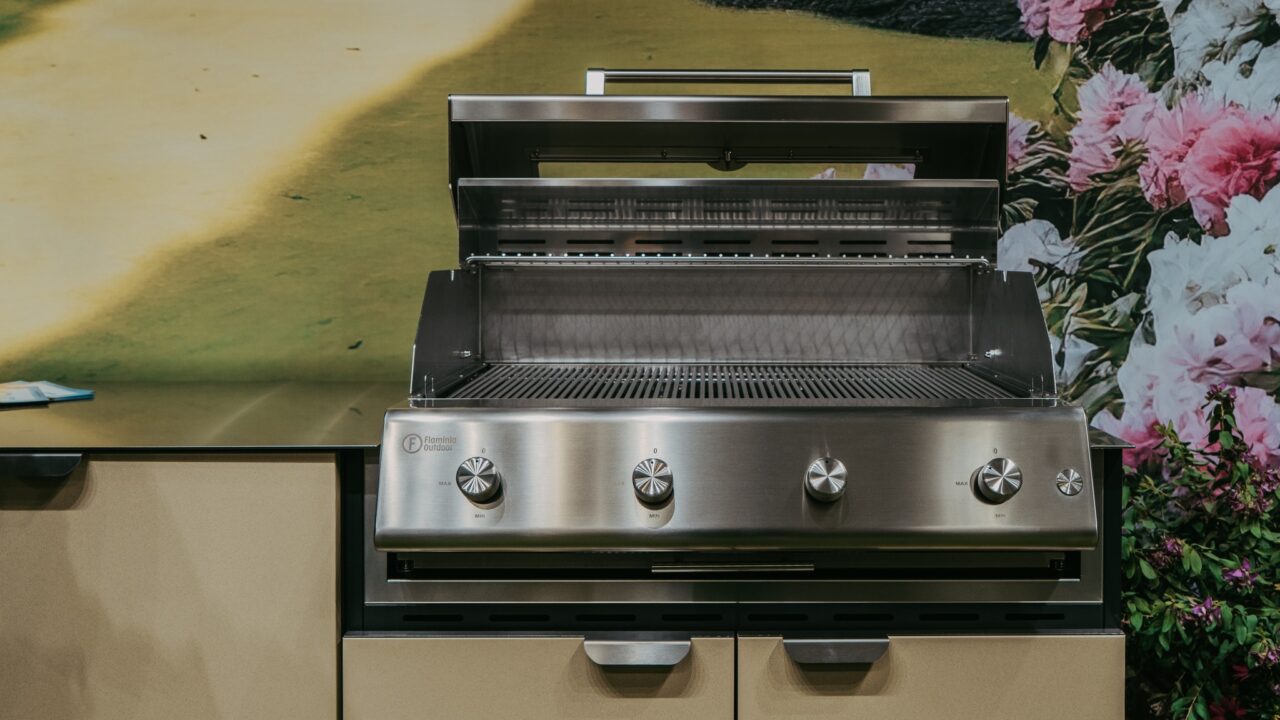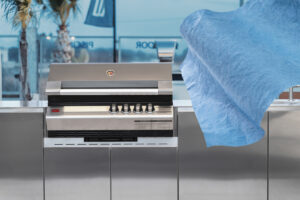Here is the English translation with the same formatting as the original:
The cooktop is the beating heart of every kitchen, but in outdoor kitchens, it takes on a fundamental role, combining functionality, durability, and style to meet all outdoor cooking needs. In this article, we will explore the various types of cooktops, with a particular focus on the materials and features that make them ideal for outdoor kitchens in stainless steel.
Main types of outdoor cooktops: what are their characteristics
Essential appliances in outdoor kitchens, each cooktop has specific features and advantages. Let’s look at the main types together.
Gas cooktops
Gas cooktops are a traditional and popular choice, appreciated for their immediate and precise response to temperature control, thanks to the use of burners powered, of course, by gas. In an outdoor kitchen, these cooktops offer unparalleled flexibility, as they are compatible with gas cylinders and fixed connections, and flame power ideal for outdoor cooking techniques such as grilling or wok cooking. However, this type of cooktop requires particular attention both in installation, to prevent gas leaks, and in cleaning.
Electric cooktops
Less common in outdoor kitchens compared to other types, electric cooktops use electric heating elements to heat the plate, simplifying their use and not requiring gas connections. However, their energy efficiency is lower and their heating and cooling time is far superior to other types. The outdoor use of electric cooktops is therefore possible but uncommon, mainly because they require adequate and safe electrical connections, as well as specific protection from exposure to moisture and atmospheric agents that could damage their components.
Induction cooktops
Like electric ones, induction cooktops require an adequate electrical connection and are therefore less suitable for outdoor use, mainly due to the sensitivity of the technology to weather conditions and the consequent constant need to protect it from factors such as humidity and bad weather. In recent years, however, induction cooktops have gained popularity thanks to their energy efficiency and their increasingly high level of safety, generated by electromagnetic fields that directly heat the bottom of compatible pots, thus reducing the risk of burns and heat dispersion. At the moment, therefore, the only disadvantage for outdoor use could be the higher initial cost compared to other types of cooktops and the need to always use specific pots.
Glass ceramic cooktops
Glass ceramic cooktops offer a modern aesthetic and an easy-to-clean surface. They use electric heating elements under a glass ceramic plate, heating pots by conduction and, although not as efficient as induction cooktops, they present themselves as an elegant and practical solution for outdoor kitchens, where they can be used by adopting precautions similar to those of electric and, indeed, induction cooktops. It is fundamental to be aware that the glass ceramic surface can be more fragile and sensitive to thermal shocks compared to other types of cooktops and that (but this also happened with electric ones!) it will take time to reach and lose the desired temperature.
Infrared cooktops
Infrared cooktops are a relatively new solution that combines the advantages of induction and glass ceramic cooktops, such as energy efficiency and ease of cleaning. Operating through halogen or radiant lamps that emit infrared heat, in this case too, outdoor use is allowed but it is necessary to have a safe electrical connection, in addition to using compatible pots.
In short, if you’ve read us this far, you will surely have understood that, regardless of the type of cooktop chosen, it is essential to ensure that it is installed following all applicable safety standards to avoid the risk of accidents or damage and that it is always adequately protected.
Innovation in outdoor cooktops: advanced materials and cutting-edge technologies
In recent years, outdoor kitchens have become a vital extension of living spaces, and cooktop manufacturers have responded with specific innovations, now part of modular systems that make outdoor cooking areas multifunctional. One of the main developments has concerned the use of increasingly advanced materials, such as marine stainless steel and reinforced glass ceramic, which guarantee superior resistance to atmospheric agents and corrosion and also facilitate cleaning, maintaining the modern and functional aesthetic. But innovation is not limited to materials: cooking systems are now advanced and specifically designed for outdoor use, ensuring resistance to climate variations and offering safety and energy efficiency. Functions such as electronic ignition, automatic shutdown systems, and flame detectors ensure safe use and reduce the risk of accidents, even in a potentially more difficult to control outdoor environment. Not only that, the most recent cooktops also integrate smart technologies, such as remote control via app, which allows monitoring and adjusting the temperature from mobile devices: a particularly useful innovation for those who want to manage multiple preparations simultaneously or want to move away from the cooking area without losing control of it.
Choosing the right cooktop for an outdoor kitchen requires careful evaluation of one’s needs, available space, and environmental conditions. Opting for materials such as stainless steel and advanced technologies can guarantee not only long durability but also a superior cooking experience. Whether it’s a summer barbecue with friends or an elegant dinner at sunset, the cooktop will always be the focal point of every preparation.






